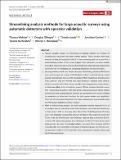Files in this item
Streamlining analysis methods for large acoustic surveys using automatic detectors with operator validation
Item metadata
| dc.contributor.author | Webber, Thomas | |
| dc.contributor.author | Gillespie, Douglas Michael | |
| dc.contributor.author | Lewis, Timothy | |
| dc.contributor.author | Gordon, Jonathan | |
| dc.contributor.author | Ruchirabha, Tararak | |
| dc.contributor.author | Thompson, Kirsten Freja | |
| dc.date.accessioned | 2022-06-16T14:30:03Z | |
| dc.date.available | 2022-06-16T14:30:03Z | |
| dc.date.issued | 2022-06-15 | |
| dc.identifier | 279750539 | |
| dc.identifier | 21ac5235-0539-423d-a0e4-bb9249f79fde | |
| dc.identifier | 85131869571 | |
| dc.identifier | 000811362600001 | |
| dc.identifier.citation | Webber , T , Gillespie , D M , Lewis , T , Gordon , J , Ruchirabha , T & Thompson , K F 2022 , ' Streamlining analysis methods for large acoustic surveys using automatic detectors with operator validation ' , Methods in Ecology and Evolution , vol. Early View . https://doi.org/10.1111/2041-210X.13907 | en |
| dc.identifier.issn | 2041-210X | |
| dc.identifier.other | ORCID: /0000-0001-9628-157X/work/114641534 | |
| dc.identifier.uri | https://hdl.handle.net/10023/25541 | |
| dc.description.abstract | 1. Passive acoustic surveys are becoming increasingly popular as a means of surveying for cetaceans and other marine species. These surveys yield large amounts of data, the analysis of which is time consuming and can account for a substantial proportion of the survey budget. Semi-automatic processes enable the bulk of processing to be conducted automatically while allowing analyst time to be reserved for validating and correcting detections and classifications. 2. Existing modules within the Passive Acoustic Monitoring software PAMGuard were used to process a large (25.4 Terabyte) dataset collected during towed acoustic ship transits. The recently developed ‘Multi-Hypothesis Tracking Click Train Detector’ and the ‘Whistle and Moan Detector’ modules were used to identify occasions within the dataset at which vocalising toothed whales (odontocetes) were likely to be acoustically present. These putative detections were then reviewed by an analyst, with false positives being corrected. Target motion analysis provided a perpendicular distance to odontocete click events enabling the estimation of detection functions for both sperm whales and delphinids. Detected whistles were assigned to the lowest taxonomical level possible using the PAMGuard ‘Whistle Classifier’ module. 3. After an initial tuning process, this semi-automatic method required 91 hr of an analyst's time to manually review both automatic click train and whistle detections from 1,696 hr of survey data. Use of the ‘Multi-Hypothesis Tracking Click Train Detector’ reduced the amount of data for the analyst to search by 74.5%, while the ‘Whistle and Moan Detector’ reduced data to search by 85.9%. In total, 443 odontocete groups were detected, of which 55 were from sperm whale groups, six were from beaked whales, two were from porpoise and the remaining 380 were identified to the level of delphinid group. An effective survey strip half width of 3,277 and 699 m was estimated for sperm whales and delphinids respectively. 4. The semi-automatic workflow proved successful, reducing the amount of analyst time required to process the data, significantly reducing overall project costs. The workflow presented here makes use of existing modules within PAMGuard, a freely available and open-source software, readily accessible to acoustic analysts. | |
| dc.format.extent | 13 | |
| dc.format.extent | 1986802 | |
| dc.language.iso | eng | |
| dc.relation.ispartof | Methods in Ecology and Evolution | en |
| dc.subject | Acoustic survey | en |
| dc.subject | Acoustics | en |
| dc.subject | Bioacoustics | en |
| dc.subject | Click train detector | en |
| dc.subject | Open-source | en |
| dc.subject | PAMGuard | en |
| dc.subject | Semi-automatic | en |
| dc.subject | QH301 Biology | en |
| dc.subject | DAS | en |
| dc.subject | SDG 14 - Life Below Water | en |
| dc.subject.lcc | QH301 | en |
| dc.title | Streamlining analysis methods for large acoustic surveys using automatic detectors with operator validation | en |
| dc.type | Journal article | en |
| dc.contributor.institution | University of St Andrews. Sea Mammal Research Unit | en |
| dc.contributor.institution | University of St Andrews. Marine Alliance for Science & Technology Scotland | en |
| dc.contributor.institution | University of St Andrews. Scottish Oceans Institute | en |
| dc.contributor.institution | University of St Andrews. School of Biology | en |
| dc.contributor.institution | University of St Andrews. Bioacoustics group | en |
| dc.contributor.institution | University of St Andrews. Sound Tags Group | en |
| dc.identifier.doi | https://doi.org/10.1111/2041-210X.13907 | |
| dc.description.status | Peer reviewed | en |
This item appears in the following Collection(s)
Items in the St Andrews Research Repository are protected by copyright, with all rights reserved, unless otherwise indicated.

